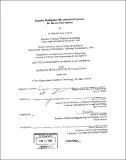Scalable multiphase microchemical systems for direct fluorination
Author(s)
De Mas Valls, Nuria, 1975-
DownloadFull printable version (9.244Mb)
Other Contributors
Massachusetts Institute of Technology. Dept. of Chemical Engineering.
Advisor
Klavs F. Jensen and Martin A. Schmidt.
Terms of use
Metadata
Show full item recordAbstract
Microchemical systems or microreactors refer to a new class of continuous reactors that have feature sizes in the submillimeter range. In particular, microfabricated chemical reactors are built using silicon-based photolithographic fabrication techniques that were originally developed to create integrated microelectronic circuits. Because silicon microfabrication allows precise control over the geometry of the reactor features down to the micron scale, as well as the integration of a variety of sensors into the fluidic path, microfabricated reactors are promising as versatile chemical synthesis tools that present capabilities exceeding those of their macroscale counterparts. In addition, small reactor volumes enhance the control of fast exothermic reactions and allow new reaction chemistries deemed too difficult to control in conventional reactors to be carried out safely. One example of such chemistry is the direct fluorination of organic molecules. This thesis addresses the design, fabrication, and application of a gas-liquid microreactor as a discovery tool for the synthesis of fluorinated compounds by direct fluorination. A microfabrication methodology was developed to create microfluidic channels chemically compatible with the highly corrosive direct fluorination environment. Electron-beam evaporated nickel in combination with thermally grown silicon oxide coatings were employed as corrosion barriers for microchannels formed in a silicon substrate. The direct fluorination of toluene was safely demonstrated at room temperature and on preparative yields for substrate concentrations ranging between 0.1 and 1.0 M. The product distribution was studied as a function of the number of fluorine equivalents and solvent type. (cont.) Extensive gas-liquid flow visualization studies were conducted in single and dual-channel devices with triangular cross section (channel hydraulic diameter of [approx.]224 [mu]m) using pulsed-laser fluorescence and continuous-wave microscopy. A gas-liquid flow regime map containing slug and annular-dry flows was obtained at flow conditions relevant for gas-liquid microchemical systems, i.e., liquid superficial velocities below 0.01 m/s. These flow visualization studies served as the design basis of a scaled-out gas-liquid reactor with a multilayer, multichannel architecture and a liquid volumetric throughput of 80 mL/h. A nonintrusive optical gas-liquid flow velocimetry technique was developed to verify uniform flow distribution across the microchannels of this reactor.
Description
Thesis (Ph. D.)--Massachusetts Institute of Technology, Dept. of Chemical Engineering, 2004. Includes bibliographical references.
Date issued
2004Department
Massachusetts Institute of Technology. Department of Chemical EngineeringPublisher
Massachusetts Institute of Technology
Keywords
Chemical Engineering.